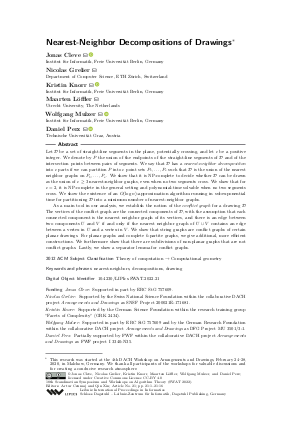Nearest-Neighbor Decompositions of Drawings
Authors
Jonas Cleve  ,
Nicolas Grelier,
Kristin Knorr
,
Nicolas Grelier,
Kristin Knorr  ,
Maarten Löffler,
Wolfgang Mulzer
,
Maarten Löffler,
Wolfgang Mulzer  ,
Daniel Perz
,
Daniel Perz 
-
Part of:
Volume:
18th Scandinavian Symposium and Workshops on Algorithm Theory (SWAT 2022)
Part of: Series: Leibniz International Proceedings in Informatics (LIPIcs)
Part of: Conference: Scandinavian Symposium and Workshops on Algorithm Theory (SWAT) - License:
 Creative Commons Attribution 4.0 International license
Creative Commons Attribution 4.0 International license
- Publication Date: 2022-06-22
File

PDF
LIPIcs.SWAT.2022.21.pdf
- Filesize: 1.25 MB
- 16 pages
Document Identifiers
Subject Classification
ACM Subject Classification
- Theory of computation → Computational geometry
Keywords
- nearest-neighbors
- decompositions
- drawing
Metrics
- Access Statistics
-
Total Accesses (updated on a weekly basis)
0Document
0Metadata
Abstract
Let 𝒟 be a set of straight-line segments in the plane, potentially crossing, and let c be a positive integer. We denote by P the union of the endpoints of the straight-line segments of 𝒟 and of the intersection points between pairs of segments. We say that 𝒟 has a nearest-neighbor decomposition into c parts if we can partition P into c point sets P₁, … , P_c such that 𝒟 is the union of the nearest neighbor graphs on P₁, … , P_c. We show that it is NP-complete to decide whether 𝒟 can be drawn as the union of c ≥ 3 nearest-neighbor graphs, even when no two segments cross. We show that for c = 2, it is NP-complete in the general setting and polynomial-time solvable when no two segments cross. We show the existence of an O(log n)-approximation algorithm running in subexponential time for partitioning 𝒟 into a minimum number of nearest-neighbor graphs. As a main tool in our analysis, we establish the notion of the conflict graph for a drawing 𝒟. The vertices of the conflict graph are the connected components of 𝒟, with the assumption that each connected component is the nearest neighbor graph of its vertices, and there is an edge between two components U and V if and only if the nearest neighbor graph of U ∪ V contains an edge between a vertex in U and a vertex in V. We show that string graphs are conflict graphs of certain planar drawings. For planar graphs and complete k-partite graphs, we give additional, more efficient constructions. We furthermore show that there are subdivisions of non-planar graphs that are not conflict graphs. Lastly, we show a separator lemma for conflict graphs.
Cite As Get BibTex
Jonas Cleve, Nicolas Grelier, Kristin Knorr, Maarten Löffler, Wolfgang Mulzer, and Daniel Perz. Nearest-Neighbor Decompositions of Drawings. In 18th Scandinavian Symposium and Workshops on Algorithm Theory (SWAT 2022). Leibniz International Proceedings in Informatics (LIPIcs), Volume 227, pp. 21:1-21:16, Schloss Dagstuhl – Leibniz-Zentrum für Informatik (2022)
https://doi.org/10.4230/LIPIcs.SWAT.2022.21
BibTex
@InProceedings{cleve_et_al:LIPIcs.SWAT.2022.21,
author = {Cleve, Jonas and Grelier, Nicolas and Knorr, Kristin and L\"{o}ffler, Maarten and Mulzer, Wolfgang and Perz, Daniel},
title = {{Nearest-Neighbor Decompositions of Drawings}},
booktitle = {18th Scandinavian Symposium and Workshops on Algorithm Theory (SWAT 2022)},
pages = {21:1--21:16},
series = {Leibniz International Proceedings in Informatics (LIPIcs)},
ISBN = {978-3-95977-236-5},
ISSN = {1868-8969},
year = {2022},
volume = {227},
editor = {Czumaj, Artur and Xin, Qin},
publisher = {Schloss Dagstuhl -- Leibniz-Zentrum f{\"u}r Informatik},
address = {Dagstuhl, Germany},
URL = {https://drops.dagstuhl.de/entities/document/10.4230/LIPIcs.SWAT.2022.21},
URN = {urn:nbn:de:0030-drops-161812},
doi = {10.4230/LIPIcs.SWAT.2022.21},
annote = {Keywords: nearest-neighbors, decompositions, drawing}
}
Author Details
Funding
- Cleve, Jonas: Supported in part by ERC StG 757609.
- Grelier, Nicolas: Supported by the Swiss National Science Foundation within the collaborative DACH project Arrangements and Drawings as SNSF Project 200021E-171681.
- Knorr, Kristin: Supported by the German Science Foundation within the research training group "Facets of Complexity" (GRK 2434).
- Mulzer, Wolfgang: Supported in part by ERC StG 757609 and by the German Research Foundation within the collaborative DACH project Arrangements and Drawings as DFG Project MU 3501/3-1.
- Perz, Daniel: Partially supported by FWF within the collaborative DACH project Arrangements and Drawings as FWF project I 3340-N35.
References
- D. Eppstein, M.S. Paterson, and F.F. Yao. On nearest-neighbor graphs. Discrete Comput Geom, 17:263-282, 1997. URL: https://doi.org/10.1007/PL00009293.
-
István Fáry. On straight-line representation of planar graphs. Acta scientiarum mathematicarum, 11(229-233):2, 1948.

-
Jacob Fox and János Pach. A separator theorem for string graphs and its applications. Combinatorics, Probability and Computing, 19(3):371-390, 2010.

-
Jacob Fox and János Pach. Computing the independence number of intersection graphs. In Proceedings of the twenty-second annual ACM-SIAM symposium on Discrete algorithms, pages 1161-1165. SIAM, 2011.

- Michael R. Garey, David S. Johnson, and Larry J. Stockmeyer. Some simplified NP-complete graph problems. Theoretical Computer Science, 1:237-267, 1976. URL: https://doi.org/10/dwvqpj.
-
Albert Gräf, Martin Stumpf, and Gerhard Weißenfels. On coloring unit disk graphs. Algorithmica, 20(3):277-293, 1998.

-
J.W. Jaromczyk and G.T. Toussaint. Relative neighborhood graphs and their relatives. Proc. of the IEEE, 80(9):1502-1517, 1992.

-
Petr Kolman and Jiřı Matoušek. Crossing number, pair-crossing number, and expansion. Journal of Combinatorial Theory, Series B, 92(1):99-113, 2004.

- Maarten Löffler, Mira Kaiser, Tim van Kapel, Gerwin Klappe, Marc van Kreveld, and Frank Staals. The connect-the-dots family of puzzles: Design and automatic generation. ACM Transactions on Graphics, 33(4):72, 2014. URL: https://doi.org/10.1145/2601097.2601224.
- Joseph S. B. Mitchell and Wolfgang Mulzer. Proximity algorithms. In Jacob E. Goodman, Joseph O'Rourke, and Csaba D. Tóth, editors, Handbook of Discrete and Computational Geometry, chapter 32, pages 849-874. CRC Press, Boca Raton, 3rd edition, 2017. URL: https://doi.org/10.1201/9781315119601.
- F. W. Sinden. Topology of thin film RC circuits. The Bell System Technical Journal, 45(9):1639-1662, 1966. URL: https://doi.org/10.1002/j.1538-7305.1966.tb01713.x.
- Tim van Kapel. Connect the closest dot puzzles. Master’s thesis, Utrecht University, 2014. URL: http://dspace.library.uu.nl/handle/1874/296600.
